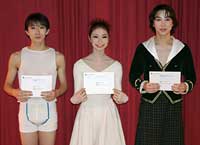|
|
|||||||
|
|
|||||||
|
|||||||
| | Web Japan >>| Trends in Japan >> | Arts & Entertainment >> | World-Class Virtuosity | |
|
WORLD-CLASS VIRTUOSITY Japanese Ballet Dancers Pirouette into the World (December 3, 2004) As the physiques of Japanese people Westernize, Japanese ballet dancers are rising up the ranks of top ballet companies of the world as principals and soloists. In addition to the improved physiques of contemporary Japanese, the diligence for which the Japanese are known has also been noted as a factor behind the success of these dancers in a world that demands steady effort. Dancing Larger Than Life Other Japanese principals at ballet theaters overseas include Takahashi Hironao of the Northern Ballet Theatre in Britain and Saito Aki at the Royal Ballet of Flanders in Belgium. Nakamura Shoko is a soloist at the Ballet Ensemble of the Vienna State Opera in Austria, and she became the first Japanese to dance the lead role of Swan Lake at the opera house. While dancing as a principal for the Dutch National Ballet, Takeshima Yumiko also owns a company that produces dancewear that she has designed. Perhaps the best-known Japanese ballet dancer is Kumakawa Tetsuya, who has gone from a principal of the British Royal Ballet to the founder of his own ballet company. In July 2004 his K-Ballet Company became the first ballet troupe from Japan to appear at the Met. At the performance, which marked its US debut, the company presented Rhapsody, one of the major works of choreographer Sir Frederick Ashton. A review in the New York Times wrote that Kumakawa executed "unimaginable steps in the air." Meanwhile the Tokyo Ballet, of which Ueno Mizuka is a principal, toured four countries in Europe in 2004. Ueno danced the lead role in Don Quixote and the solo part in Bolero and was praised by a Belgian newspaper as an excellent ballerina who dances with both grace and precision. Diligence and Mental Strength The Japanese physique, typically characterized by longer torsos and shorter legs than Westerners, was once considered unsuited to ballet. But over the decades this has changed, and today's young Japanese have longer limbs and higher waists. This endows these dancers with the ability to perform ballet with more expression and flair. More importantly, though, the characteristic diligence of the Japanese is seen to be an important factor in the emergence of Japanese dancers on the international ballet scene. Surviving in the world of ballet requires an enormous amount of daily effort and training, so much so that ballet can be said to start and end with the basics. Also, those who overcome the language barrier and live comfortably overseas all share a mental toughness. Japanese ballet dancers performing internationally are undoubtedly contributing to the better understanding and appreciation of Japan and its people around the world. Copyright (c) 2004 Web Japan. Edited by Japan Echo Inc. based on domestic Japanese news sources. Articles presented here are offered for reference purposes and do not necessarily represent the policy or views of the Japanese Government. |
90 MAGICAL YEARS OF TAKARAZUKA (March 17, 2004) LET'S DO THE PARA-PARA! (July 28, 2000) LET'S DANCE (June 14, 1999) |
|
|



